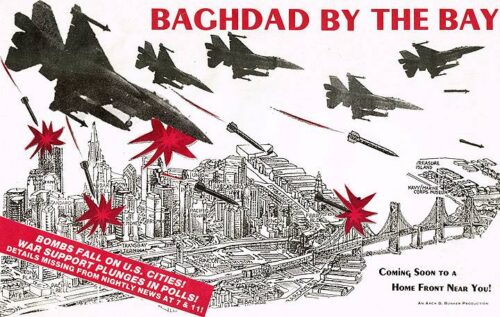
“Three Days of Rage” — opens up with a declaration from the former SF anarcho-punk band Crucifix: “Peace, or annihilation,” a dial tone, and then the guitar and drums kick in. The underground film is centered on three critical, consecutive days of antiwar protest in San Francisco — the day before the start of the Gulf War, the first day of U.S. military operations, and the day after — in January 1991.
Filmmaker Michael Kavanagh tells the story of the “Three Days of Rage” from within the heart of the protests, using his own camcorder footage alongside newsreel clips and shots of printed flyers to create a decentralized non-narrative that speaks more to the momentum and potential of the crowd than to any overarching history. This position within the immediately-present rage protects the sense of hope, possibility, and experimentality inherent in such an expression, and it suspends the viewer in this unique moment after-Vietnam but before the world-we-know-now is born: before 20 years in Afghanistan and over a decade in Iraq; before the newest incursions into Yemen, Syria, Libya, Iran; before drone strikes; before aid trucks became military tactics and hospitals became graveyards; before this chapter of the US-funded Israeli genocide against Palestinians.
Before NGOs demobilized swaths of people and surveillance capitalism threatened to kneecap the rest, 20,000 people were brought together by word of mouth, a few printed flyers, and a spontaneous, uniting rage. The rhythm, tone, and energy in “Three Days of Rage” is markedly different from the scene today, and is an important point of reference for what we’ve carried over and what we’ve lost over the last three decades of movement.
On the morning of the Day 1, one protestor tells a reporter that they’ve formed a parade around the Federal Building that has no start and no stop, just a continuous flow. “Three Days of Rage” is one instantiation in this long parade, this long history of riot, revolt, and resistance that has no beginning and has no end, that imperfectly passes (sometimes dropping entirely, only to skip a generation and be discovered again by the next) from one hand to the next the tactics, the lessons, the forms and the substance and the poetry and the anger of a people united.

